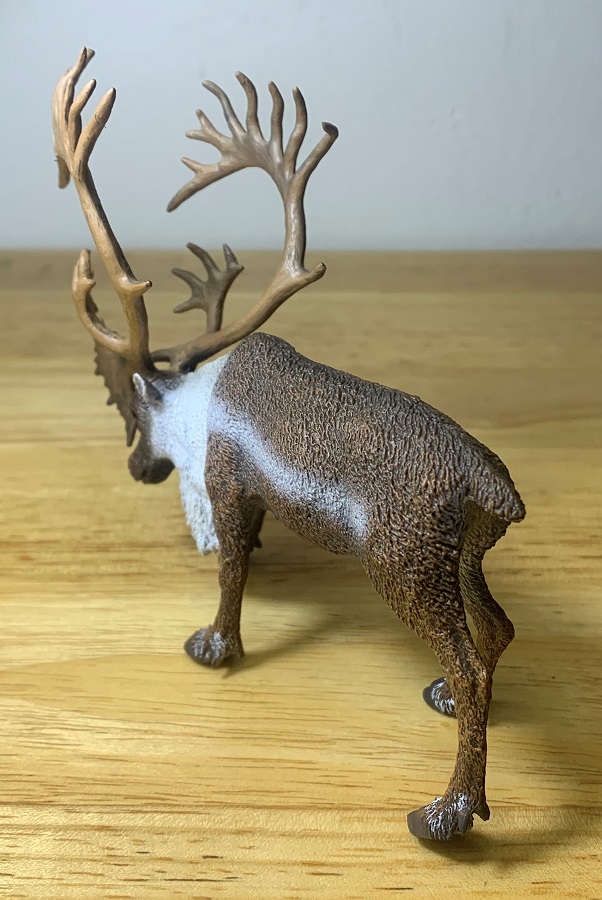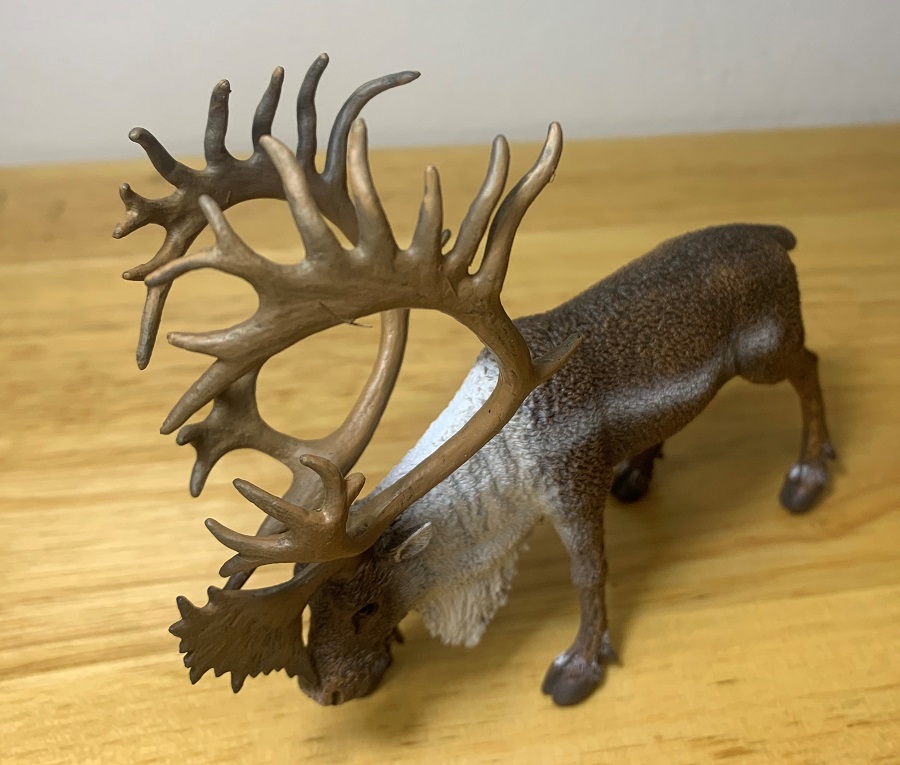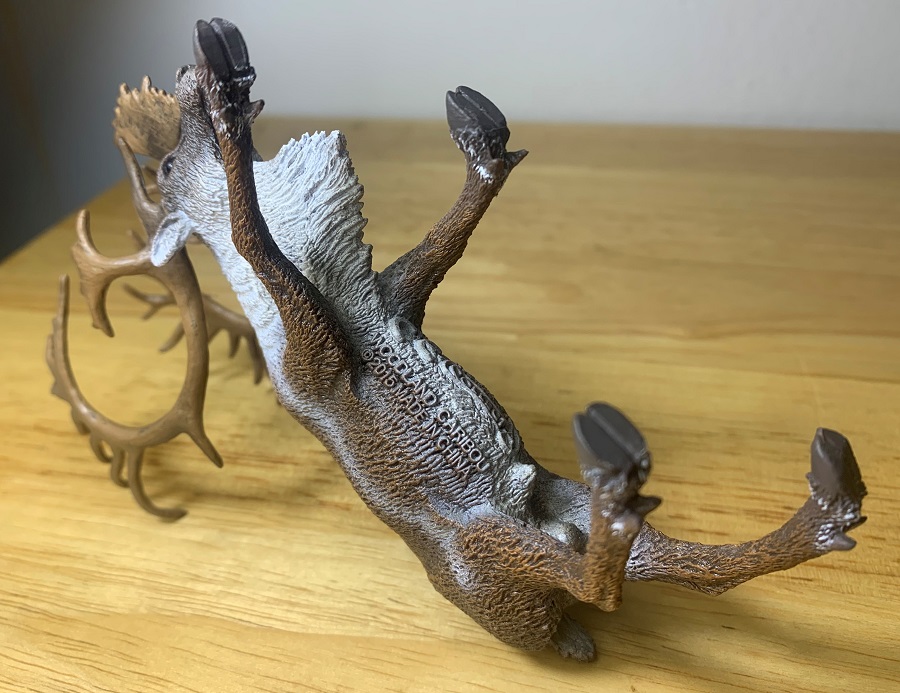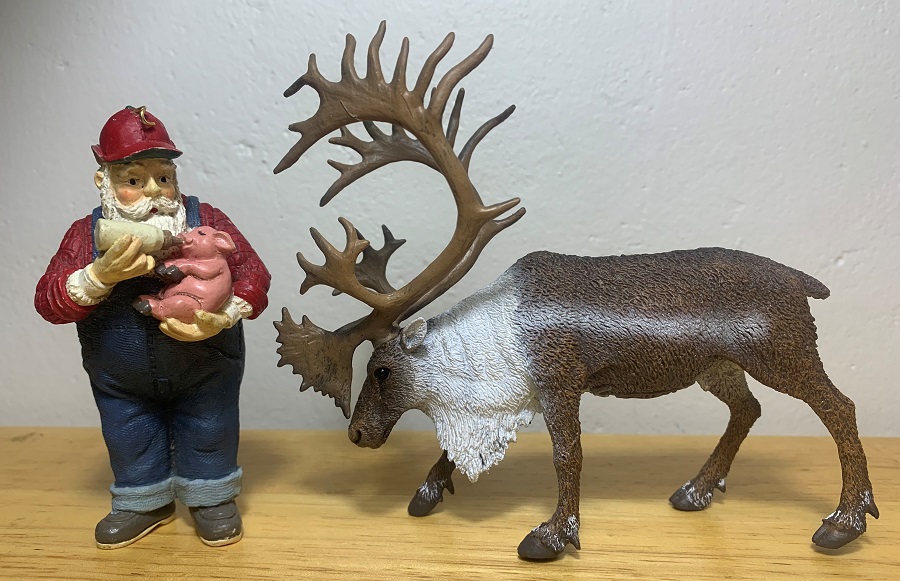Everyone knows that Santa’s sleigh is pulled by reindeer (Rangifer tarandus) but with 14 extant sub-species currently described has anyone ever wondered what kind of reindeer are pulling it? Probably not. But according to the 1823 poem (which also gave the reindeer their names) A Visit from St. Nick, now known as The Night Before Christmas, Santa’s miniature sleigh was pulled by “eight tiny reindeer”. Well, if they are indeed tiny than the most likely sub-species would have to be the Svalbard reindeer (R. t. platyrhynchus) whose males top out at 198 lbs. (90 kg). One subspecies it couldn’t be, would be the woodland caribou (R. t. caribou), the largest reindeer sub-species whose males can reach 462 lbs. (210 kg). That said, looking at the subject of today’s review, the CollectA woodland caribou, it certainly looks fit for the task.

Common names can be a tricky thing, because they’re often the names given to a species by the locals it lives amongst. In the case of wide-ranging species this can mean many names for the same species. Thankfully we have scientific names, which are the same no matter where you go. Reindeer is the European name for R. tarandus and caribou is the North American name for the same species. I’ll be using both common names throughout the review.

Reindeer have a circumpolar distribution, living in arctic, sub-arctic, tundra, boreal forests, and mountains in northern Europe, Siberia, and North America. The woodland caribou sub-species is found in mature forests, bogs, swamps, and lakeshores throughout most of Canada and used to range into the northern United States but as of only a few years ago is now extirpated there.

The CollectA woodland caribou, produced in 2015, measures 5” (12.7 cm) long, stands 4” (10.16 cm) tall to its highest point, and 2.5” (6.35 cm) at the shoulder. The actual woodland caribou stands 3.6’ to 4.6’ (1-1.4 meters) tall at the shoulder. This puts the CollectA figure at 1/20 in scale and it represents a male, or bull.

The figure is presented with its head tilted down and right forelimb gently pawing at the ground, perhaps removing some snow to search for its preferred diet of lichens. Indeed, caribou hooves have sharp edges and are concave on the underside, specifically adapted to search for lichens under snow. They also feed on grasses, sedges, horsetails, and other vegetation. Their fondness for lichens also means that only mature forests can sustain them. The CollectA toy doesn’t have concave hooves, but should we really expect it to?

The most immediately noticeable feature of this figure is its enormous set of antlers, and it was this standout feature that drew me to this figure. There are plenty of reindeer figures out there but none of them are quite like this one, and you could say I’m a bit of a trophy hunter where toy deer are concerned. Such a rack might seem exaggerated, but it isn’t far off from reality, although it’s certainly exemplary and would perhaps be better applied to a barren-ground caribou which has the largest antlers of all reindeer subspecies. Regardless, it would have to be an older dominant bull in his prime to sport such a rack. Caribou have the largest set of antlers in ratio to body size of any deer species, and second in overall size after the moose (Alces alces).

Female caribou, or cows, also grow antlers. They’re the only female deer species that normally do, but they’re typically smaller than those of males. Generally, male caribou shed their antlers in November and December. This has led to some speculation as to the sex of Santa’s reindeer and if they might be female, since females retain their antlers until the summer, but young males also often retain their antlers, at least until spring.

Looking over the rest of the figure we see a wide, square shaped muzzle on a long rectangular snout, large and bright cow-like eyes, shaggy hair hanging off the dewlap of its neck, large hooves, and a small tail. The figure is detailed with a covering of fine hairs. Woodland caribou have a wooly, dense undercoat, and an outside coat of hollow, air-filled hairs.

The CollectA caribou is predominantly dark brown, and woodland caribou tend to have the darkest colored pelts of all reindeer. The figure is white around the neck with white coloration continuing in a horizontal stripe running down the sides. The figure is also painted white on the underside, and around the genitals and rump. Some white hair is painted around the muzzle and dark brown hooves, and the antlers are a milk chocolate color.

The CollectA woodland caribou is a beautiful sculpt and example of the subspecies, and the reindeer species in general. In seeking out a reindeer to review this holiday season, and add to my collection, it was no contest. CollectA excels at ungulates, and this caribou is a testament to that fact. It’s also notable in being one of the few to represent a specified subspecies. My only complaint about it is that because it’s front heavy, my copy tilts forward, lifting one of it’s hindlegs off the ground. The CollectA woodland caribou retails for about $10 and makes the perfect stocking stuffer for the toy animal collector in your life, young or old.

Disclaimer: links to Ebay and Amazon on the AnimalToyBlog are affiliate links, so we make a small commission if you use them. Thanks for supporting us!




Well done! I think this is the finest caribou figure anyone has made to date.
When thinking about Santa’s reindeer all I can think of is Rudolph and as such I think of the song…
…and in that song Rudolph and all of Santa’s other reindeer were juveniles which explains their small size. At least in that story.